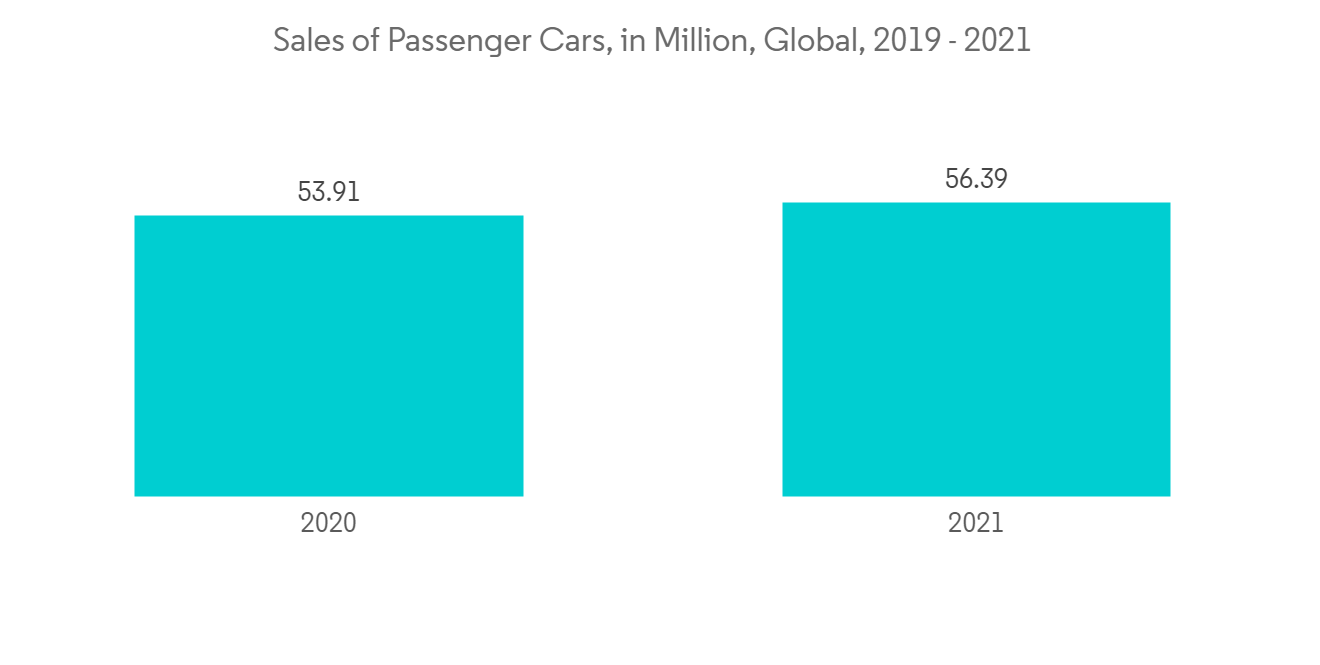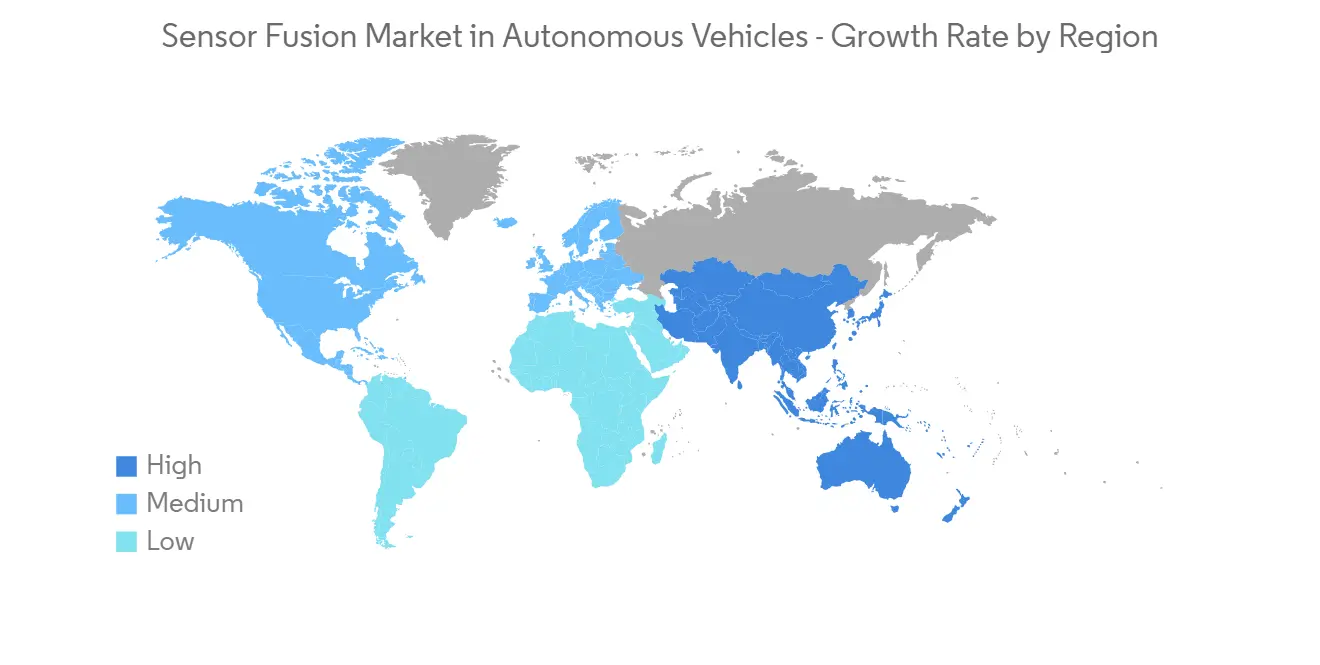PUBLISHER: Mordor Intelligence | PRODUCT CODE: 1237846

PUBLISHER: Mordor Intelligence | PRODUCT CODE: 1237846
Sensor Fusion Market In Autonomous Vehicles - Growth, Trends, And Forecasts (2023 - 2028)
The sensor fusion market in autonomous vehicles is expected to grow by registering a CAGR of 19.6% during the forecast period. The growing trend of including advanced functionalities in autonomous vehicles, such as advanced driver assistance systems (ADAS), new radar systems, cameras, lidar, and GNSS sensors enhanced the requirements of flexible systems to quickly and safely detect the variables and respond, which is also among the significant factors driving the growth of sensor fusion in the autonomous vehicle sector.
Key Highlights
- Resolving contradictions between sensors, synchronizing sensors, predicting the future positions of objects, and achieving automated driving safety requirements are some of the primary objectives of sensor fusion in an autonomous vehicle application. According to the World Economic Forum, more than 12 million fully autonomous cars are expected to be sold annually by 2035. Autonomous vehicles will account for 25% of the global automotive market. According to Intel, a single autonomous vehicle can generate an average of 4 terabytes of data per day. Sens fusion solutions can play a significant role in utilizing this massive data in real time.
- The growing development in ADAS and increasing utilization of the principle of GPS-IMU (Inertial Measurement Unit) fusion helps solve accumulated errors of dead reckoning in intervals with absolute position readings. Tesla's Autopilot automated driving feature is an example of an ADAS that can perform functions such as keeping the vehicle center in a highway lane by determining its precise position from data collected from a forward-facing camera and sensors.
- Collaboration between automotive and software companies is a common trend in the market. For instance, in April 2021, RoboSense, a lidar sensor provider, formed a partnership with Banma Network Technology, an intelligent automobile operating system and solution provider, and AutoX, China's leading robotaxi operator, to build a high-level autonomous driving platform for intelligent vehicles. The partnership was established primarily to promote the integration of intelligent cockpits with autonomous driving systems through the fusion of AI Capabilities, hardware, and software.
- Stringent government regulations globally also fuel the demand for the products in the market studied. For instance, Euro NCAP (European New Car Assessment Program) mandates the deployment of at least one driver assistance system. Countries like Japan and the United States also adopt similar criteria in their national NCAP rules.
- The growing safety issue of autonomous technology can not only limit the adoption of autonomous vehicles but could claim the authenticity of sensor fusion solutions. Standardization is one of the factors hindering the evolution of sensor fusion systems. Without global standards, the level of complexity of devices and ICs is expected to increase exponentially.
- The COVID-19 outbreak increasingly affected the automotive sector globally. Due to reduced outdoor activities, the demand for automobiles declined significantly, primarily during the initial phase of the pandemic. Furthermore, the reduced supply of automotive parts and shutdown of production facilities fell the working capital of automobile manufacturers, resulting in a delay or reduction in investments in new technologies. However, with the automotive sector recovering from the pandemic, new opportunities are on the horizon for sensor fusion solution providers.
Autonomous Vehicles Sensor Fusion Market Trends
Passenger Cars to Hold a Significant Market Share
- There is an increasing interest among passenger car makers in developing autonomous cars, owing to the growing demand for vehicles with premium features. Car manufacturers, technology companies, and researchers are continuously working on further developing the technologies behind the autonomous car. As these vehicles include multiple sensors that gather massive amounts of data, sensor fusion emerged as an ideal solution to enable vendors to use the sensor data intelligently.
- Recent years have witnessed an upward growth trend in passenger vehicle sales. Although the pandemic affected the growth, the impact is more in the short term, which is expected to gain traction in the next few years. For instance, according to OICA, in 2021, sales of passenger cars increased to 56.4 million units from 53.9 million in 2020. Such trends are expected to act as a significant driving factor for the growth of the studied market.
- One crucial aspect of autonomous vehicles is path planning. Sensor fusion plays an essential role here by integrating the sensor readings to construct a precise picture of the vehicle's state and predict the trajectories of the surrounding objects. Hence, the adoption would increase with the increase in passenger car sales, which are autonomous in the coming times.
- Furthermore, Autonomous Emergency Braking (AEB) is an enhanced active safety system that helps drivers avoid or mitigate collisions with other vehicles or vulnerable road users. Multiple sensors are often needed for accurate, reliable, and robust detections while minimizing false positives. With safety becoming an increasingly important issue in the automotive industry, especially in the passenger vehicle segment, the increasing adoption of AEB systems is expected to impact the demand for sensor fusion systems positively.

North America to Retain a Significant Market Share
- North America is among the largest automotive manufacturing hubs in the world. The economic growth of the region posed an impact on the sale of passenger cars and commercial vehicles. The United States is among the leading automobile manufacturers in the North American region; apart from high domestic consumption, the country also exports automobiles globally. For instance, according to the US International Trade Commission, the export volume of light vehicles reached 1,619.35 thousand units in 2021.
- The region is also among the pioneers in adopting ADAS-enabled vehicles and self-driven transportation solutions. According to Deutsche Bank, the US ADAS unit production volume was forecasted to reach 18.45 million by 2021. ADAS (advanced driver-assistance systems) is capable of supporting adaptive cruise control (ACC), automatic emergency braking (AEB), lane departure, blind-spot detection, 360° surround view, etc., as a lot of sensors are used in designing the ADAS systems, such trends are expected to drive the demand for sensor fusion solutions in the country.
- According to ITA, Canada is the second largest automotive market in the North American region, where imports represent about three-quarters of the new vehicles market. In 2021, the import value of passenger vehicles increased by about 26% (compared to the last year) to USD 27.8 billion. The country's acceptance of autonomous cars is growing significantly, encouraging automobile manufacturers to increase their investment. For instance, tech and motor companies like Tesla, Uber, Toyota, BMW, GM, and Nissan are all in the race to develop autonomous vehicles for Canadian consumers.
- Furthermore, Robotaxis (relying on a powerful array of advanced sensing technologies that include multiple LiDARs to maneuver complex urban environments safely) is not quite here. Still, Waymo, Cruise, and Uber are investing heavily in and operating experimental fleets in the United States, which is expected to create future opportunities.

Autonomous Vehicles Sensor Fusion Market Competitor Analysis
The Sensor Fusion Market in Autonomous Vehicles is moderately competitive, owing to the mixed presence of both large-scale companies, such as Bosch, STMicroelectronics, and NXP Semiconductors NV, as new players specifically focused on this technology. The vendors are increasingly focusing on developing the technology to prepare it for future autonomous vehicles and make it affordable.
October 2022 - MicroVision, a leading American automotive sensor solution provider, unveiled MAVIN DR, a dynamic view lidar system, at the AutoSens 2022 Show in Brussels. The MAVIN DR lidar system features a dynamic field of view. It delivers high resolution with low latency, enabling new ADAS safety feature designers to achieve the proper highway-pilot functionality that OEMs demand.
April 2022 - CARIAD, the Volkswagen Group's software company, acquired the automotive division of Intenta GmbH, which works in sensor data fusion. The acquisition is in line with the company's strategy to massively increase its vertical value creation in software and hardware development to enable itself to develop critical software components in-house and increase the depth of value added in key development areas.
Additional Benefits:
- The market estimate (ME) sheet in Excel format
- 3 months of analyst support
TABLE OF CONTENTS
1 INTRODUCTION
- 1.1 Study Assumptions and Market Definition
- 1.2 Scope of the Study
2 RESEARCH METHODOLOGY
3 EXECUTIVE SUMMARY
4 MARKET INSIGHTS
- 4.1 Market Overview
- 4.2 Industry Attractiveness - Porter's Five Forces Analysis
- 4.2.1 Bargaining Power of Suppliers
- 4.2.2 Bargaining Power of Buyers
- 4.2.3 Threat of New Entrants
- 4.2.4 Intensity of Competitive Rivalry
- 4.2.5 Threat of Substitute Products
- 4.3 Industry Value Chain Analysis
- 4.4 Technology Snapshot
- 4.5 Impact of COVID-19 on the Market
5 MARKET DYNAMICS
- 5.1 Market Drivers
- 5.1.1 Growing Demand for Autonomous Vehicles
- 5.1.2 Efficient Real Time Data Processing and Data Sharing Capabilities to Drive the Demand
- 5.2 Market Restraints
- 5.2.1 Lack of Standardization in Sensor Fusion Technology
6 KEY MARKET TRENDS
- 6.1 Key Patents and Research Activities
- 6.2 Major and Emerging Applications
- 6.2.1 Adaptive Cruise Control (ACC)
- 6.2.2 Autonomous Emergency Braking (AEB)
- 6.2.3 Electronic stability control (ESC)
- 6.2.4 Forward Collision Warning (FCW)
- 6.2.5 Other Applications
7 MARKET SEGMENTATION
- 7.1 By Types of Vehicle
- 7.1.1 Passenger Cars
- 7.1.2 Light Commercial Vehicle (LCV)
- 7.1.3 Heavy Commercial Vehicle (HCV)
- 7.1.4 Other Autonomous Vehicles
- 7.2 By Geography
- 7.2.1 North America
- 7.2.2 Europe
- 7.2.3 Asia-Pacific
- 7.2.4 Latin America
- 7.2.5 Middle East & Africa
8 COMPETITIVE LANDSCAPE
- 8.1 Company Profiles
- 8.1.1 Robert Bosch GmbH
- 8.1.2 Microchip Technology Inc.
- 8.1.3 Infineon Technologies AG
- 8.1.4 BASELABS GmbH
- 8.1.5 NXP Semiconductor
- 8.1.6 STMicroelectronics NV
- 8.1.7 Aimotive kft
- 8.1.8 Kionix Inc (Rohm Co. Ltd)
- 8.1.9 TDK Corporation
- 8.1.10 CEVA Inc.
9 INVESTMENT ANALYSIS
10 FUTURE OUTLOOK OF THE MARKET




